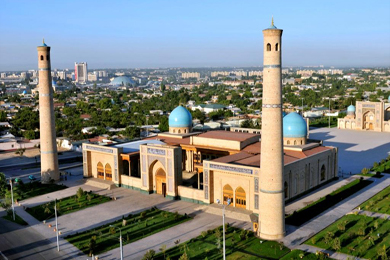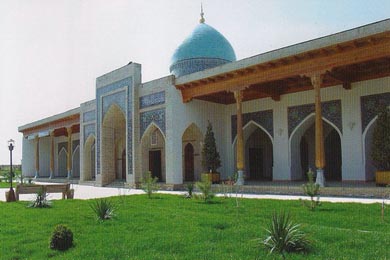Sights of Tashkent
TASHKENT - the capital of the Republic of Uzbekistan - has more than 2000 years. This amazingly beautiful and welcoming city has gone from a tiny oasis to the largest city in Central Asia. The first traces of life in the city - 15-12 thousand years BC (Upper Paleolithic site in Karakamysh and Bozsu). The first settlement on the site of Tashkent - VI - IV centuries. BC. (Shashtepa). Mounds of nomads of the Sarmatian culture - II - I centuries. BC. (Shashtepa). Fortified settlements in Tashkent - I - IV centuries. AD (Durmen).
One of monuments of an era of temurid, ancient and not numerous in the territory of Tashkent. It is constructed after the death of the governor of Tashkent of Yunus-hana (1415-1487). Hudzhra (cell) are placed to two floors. The external dome of the hall is established on a cylindrical drum. The hall is opened by apertures from three parties. It conceals many riddles - in it it was not revealed burials, and surprising doors were musical as between their shutters ancient east musical instrument - Chiang was skillfully built-in.
- Details
- Category: Sights of Tashkent
- Hits: 2
Hazret Imam complex (15th century). Gives fuller picture about the developed architectural forms of medieval Tashkent. The ensemble developed on a grave of one of the first imams of Tashkent, the famous scientist, expert on the Koran and hadis Hazreti Imam (his full name - Abubekr Mahomed Kaffal of Shashi). By name the sheikh all area in this part of the old city received the name Hazreti Imam.
- Details
- Category: Sights of Tashkent
- Hits: 2
The mausoleum Abubekra Mahomed Kaffal of Shashi (1541-42) Abubekr Mahomed Kaffal of Shashi - one of the first imams of the Muslim world, the famous Muslim scientist, the expert on the Koran, hadis, the Islamic law and a lexicology. He died in 976/77 g, its grave became the place of worship, it was honored and popular. There is a legend that to it the Saint sheikh Zaynaddin-bobo went to worship by the underpass from other part of the city. There is a legend that the nickname Kaffal ("zamochnik") is scarlet he got for production of the surprising lock which key weighed one and a half kilograms.
- Details
- Category: Sights of Tashkent
- Hits: 2
Mosque Tillya-Sheykh (1856-57). It is located opposite to madrasah Barack khan. It was constructed by the Kokand khan Mirza Ahmed Kushbegi. In the yard of the mosque there are winter and summer rooms for prayers; low minarets; economic rooms and library. The mosque is decorated by a carved mikhrabny niche, a minbar, window openings. According to the legend the gold hair of the prophet Mahomed is stored here.
- Details
- Category: Sights of Tashkent
- Hits: 2
The mosque Namazgokh (the middle of XIX in). In the past this was the country territory where the people on the main religious holidays gathered. Now in this building the Islamic institute of a name of the Imam Al Bukhari is placed. His main facade leaves in internal, a small court yard now. The building presents itself the extended construction in the form of dome galleries with a wooden ayvan.
- Details
- Category: Sights of Tashkent
- Hits: 2
Sheikh Zaynutdina-bobo's mausoleum (16th century). Sheikh Zaynutdin-bobo is a son of the founder of the Sufi award Sukhravardiya - the sheikh Ziya hell dyne of Dzhakhim of Sukhravardi. It was sent by the father to these places for distribution of the ideas of a Sufi award. Sheikh Zaynutdin-bobo was buried in the country settlement of Arifon behind gate of Kukcha. The monument belongs to type of mausoleums-hanaka. The main entrance is allocated peshtoky. The hall is blocked by a double sferokonichesky dome. The external dome is lifted on a high drum.
- Details
- Category: Sights of Tashkent
- Hits: 2
Is to the settlement of Zangi-Ata near Tashkent. The ensemble evolved from burial of the sheikh Ah-Hodge known as Zangi-ata that means "black", the 12th century living in the end. It was the fifth myurid Hodge Ahmad's sufiya of Yassavi who was considered as the spiritual head of all Turkic tribes of Central Asia and Kazakhstan. According to the legend, the foundation was laid for ensemble by Amir Temur who built the mausoleum. The ensemble consists of an extensive garden, a complex of constructions where enter the mosque, madrasah, a minaret and the mausoleum Ambar-bibi.
- Details
- Category: Sights of Tashkent
- Hits: 2
The mosque Minor Masjidi — the new mosque in the capital of Uzbekistan Tashkent. The mosque is located on the bank of Ankhor channel which embankment for the last months underwent considerable changes in the plan of improvement.
Construction of the mosque "Minor" was begun in the summer of 2013 on the basis of the resolution of the President of the Republic of Uzbekistan Islam Karimov "About measures for construction of the mosque in the territory waved "Minor" of the city of Tashkent". On October 1, 2014, on the eve of a sacred holiday of Muslims.
- Details
- Category: Sights of Tashkent
- Hits: 2












